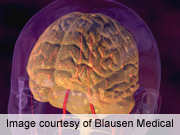
THURSDAY, Aug. 2 (HealthDay News) — The deadly march of Alzheimer’s disease is slower in people aged 80 or older than the younger elderly, researchers have found.
The risk of developing Alzheimer’s disease increases with age, and by 85, the risk is about 50 percent. But those who develop the progressive brain disorder that late in life will experience a less aggressive disease than those whose symptoms appear at 60 or 70 years, according to investigators at the University of California, San Diego.
Lead researcher Dominic Holland from the university’s neurosciences department said doctors will need to consider these findings when assessing older patients for Alzheimer’s disease.
“Methods for early detection, which will rely on biomarkers as well as mental ability, will need to take into account the age of the individuals being assessed,” he said. Because the “old” elderly may deteriorate at a slower pace than younger patients, doctors may not realize these people are suffering from Alzheimer’s disease.
The findings also have implications for clinical trials evaluating potential Alzheimer’s treatments and cost-of-care projections for different Alzheimer’s patients, Holland and other experts say.
Currently, no effective treatments exist to slow or cure Alzheimer’s disease, which gradually destroys brain cells and robs people of memory, and their ability to communicate and carry out everyday tasks.
The report was published Aug. 2 in the online journal PLoS One.
To study Alzheimer’s disease progression, Holland and colleagues used data from the Alzheimer’s Disease Neuroimaging Initiative study. They looked at more than 700 people aged 65 to 90, some with normal mental functioning, some with mild signs of dementia and others suffering from Alzheimer’s.
Participants were tested every 6 or 12 months.
The researchers found that younger Alzheimer’s patients lost their mental abilities faster than older patients.
These declines among younger patients paralleled the accelerated rate of brain tissue loss and the increase in a spinal-fluid indicator of Alzheimer’s seen among the younger age group, compared with older patients, the study authors added.
The researchers aren’t sure why Alzheimer’s is more aggressive in younger patients. One explanation might be that the older patients have been declining at that slower rate over a longer time, with some unknown factor keeping symptoms at bay, they suggest.
Another possibility is that the older patients have dementia plus Alzheimer’s, which might stall the full effect of Alzheimer’s on the brain. But such a diagnosis must be made with an autopsy, which is the only way Alzheimer’s is accurately diagnosed, Holland noted.
Alzheimer’s disease currently affects an estimated 5.6 million Americans, and that number is expected to triple by 2050 as the baby boom generation ages.
The finding that the earlier one develops the disease, the more aggressive it is isn’t good news for those younger elderly patients who will suffer the worsening loss of their mental abilities for a long time, Holland said.
Another expert said the findings may affect both health cost projections and clinical trials.
“This is an extremely important paper with implications for both the projections of cost of care for Alzheimer’s disease and for planning clinical trials,” said Dr. Sam Gandy, associate director of the Mount Sinai Alzheimer’s Disease Research Center at the Mount Sinai School of Medicine in New York City.
If the clinical picture in the over-85 population is milder than what is typical in younger populations, those older patients would remain independent longer, and the projections for the economic burden to the health care system should be adjusted, he said.
“The annual cost now is $200 billion in the U.S.; the projection is $1 trillion annually by 2050,” Gandy said.
“Maybe that $1 trillion is really only $500 to $750 billion. Still catastrophic, but it is worth considering this in projection,” he added.
Equally important, if the rate of decline is slower in 85-year-olds than in 65-year-olds, that must be taken into account when recruiting for clinical trials, Gandy said.
For example, if all the patients receiving a drug were over 85 and all the patients receiving an inactive placebo were much younger, it might appear the drug was working when, in fact, the populations were improperly matched, Gandy pointed out.
“We have known that we wanted populations to be as identical as possible, but we didn’t really know of this specific phenomenon before,” he said.
More information
For more information on Alzheimer’s disease, visit the Alzheimer’s Association.

